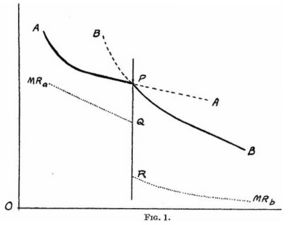Kinked demand curve

A "kinked" demand curve is a bent demand curve for an oligopoly. If the oligopoly raises its price above the kink, then sales will decline sharply because the other sellers will be underselling it and are not likely to raise their prices also. But if the oligopoly reduces its price below the kink, then the other sellers are likely to follow and sales will not increase much either.
Thus the market price for an oligopoly tends to settle at the kink.
History and Criticism
The kinked demand curve theory was created to challenge classical economics with respect to efficient markets and the ability of pricing to react quickly to changes in demand. Supporters of the kinked demand curve also supported the notion of sticky prices.
Conservative classical economists, such as George Stigler, reacted with research suggesting that there is no such thing as a kinked demand curve, even in oligopolistic markets.